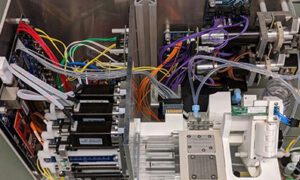Are you ready to take your business to new heights by harnessing the power of hyperscale computing? In today’s digital era, where data and technological advancements are evolving at a rapid pace, businesses must stay ahead of the curve. But with so many options available, how do you know which type of hyperscale computing is right for your organization? Fear not! In this blog post, we’ll break down the different types of hyperscale computing and help you navigate through the maze of choices. Get ready to revolutionize your business as we explore the world of hyperscale computing together!
Introduction
A hyperscale computing system is a computer architecture that can scale up or down as needed to handle changing workloads. It is designed to provide on-demand scalability so that it can elastically grow or shrink its capacity in response to changes in demand.
Hyperscale systems are typically built using commodity hardware and open-source software, which makes them much more cost-effective than traditional enterprise systems. They are also highly fault-tolerant, so if one component fails, the system can continue to operate without interruption.
The key advantage of hyperscale computing is its flexibility. It can be used for a wide range of workloads, from small web applications to large data warehouses. And because it is built using commodity hardware, it can be easily scaled up or down as needed.
There are two main types of hyperscale architecture: public and private. Public hyper-scale systems are offered by cloud providers such as Amazon Web Services (AWS) and Microsoft Azure. Private hyperscale systems are usually built by enterprises for their own use.
So which type of hyperscale system is right for your business? It depends on your needs and budget. If you need the flexibility and scalability of a public hyperscale system but don’t want to pay for it, you can build your own private hyperscale system using commodity hardware and open-source software. Or if you need the performance and security of a private hyper-scale system but don’t have the time
Types of Hyperscale Computing
Hyperscale computing is a type of cloud computing that refers to the delivery of scalable IT resources—including infrastructure, platforms, and storage—as an on-demand service. Hyperscale computing services are designed to meet the needs of organizations that require high levels of scalability and flexibility.
There are four main types of hyperscale computing: public, private, hybrid, and multicloud.
Public hyper-scale computing refers to services that are delivered over the internet by a third-party provider. Private hyper-scale computing refers to services that are delivered over a private network by a third-party provider. Hybrid hyperscale computing refers to services that are delivered over both a public and a private network by a third-party provider. Multi-cloud hyper-scale computing refers to services that are delivered across multiple cloud environments by multiple providers.
Which type of hyperscale computing is right for your business? It depends on your specific needs and requirements. If you need the highest level of scalability and flexibility, public hyperscale computing may be the best option for you. If you require more control over your data and security, private or hybrid hyper-scale may be a better fit. And if you need to access multiple cloud environments, multi-cloud hyperscale is likely your best option.
Public Cloud Computing
Public cloud computing is a type of hyperscale computing in which businesses make use of the public cloud to store, manage, and process data. The public cloud is a network of remote servers that are owned and operated by a third-party service provider. Businesses that use the public cloud can take advantage of the scalability and flexibility it offers, as well as the pay-as-you-go pricing model.
Private cloud computing
Private cloud computing is a type of hyperscale computing in which a company uses its data center resources to provide cloud services, usually to its employees or customers. This type of cloud computing can offer many benefits, including improved security and privacy, greater control over data and applications, and increased performance.
Hybrid cloud computing
Most businesses today rely on some form of cloud computing to keep their operations running. But what is the cloud, exactly? And what are the different types of cloud computing?
The cloud is a network of servers that store and provide access to data and applications over the Internet. Cloud computing is the delivery of these services—including storage, processing, and other computations—on demand.
How to Make a Decision on the Right Type of Hyperscale Computing for Your Business
The first step in making a decision on the right type of hyperscale computing for your business is to understand the different types of hyperscale computing options available. The three most common types of hyperscale computing are public cloud, private cloud, and hybrid cloud.
A public cloud is a type of hyper-scale computing that uses resources that are owned and operated by a service provider, such as Amazon Web Services (AWS) or Microsoft Azure. Public cloud services are typically delivered over the Internet, and customers can access them on a pay-as-you-go basis.
A private cloud is a type of hyperscale computing that uses resources that are owned and operated by a single organization. Private clouds can be deployed on-premises or off-premises. Private clouds offer more control and security than public clouds, but they can be more expensive to deploy and manage.
A hybrid cloud is a type of hyperscale computing that uses resources from both public and private clouds. Hybrid clouds can be used to create a “burst” environment for compute-intensive workloads or to provide failover capabilities in the event of an outage. Hybrid clouds offer the best of both public and private clouds, but they can be more complex to deploy and manage.
Conclusion
Hyperscale computing is a powerful tool that can help businesses of all sizes scale up and expand their operations while minimizing costs. With the right type of hyperscale computing, your business can take advantage of increased storage capacity and flexibility, as well as improved scalability and performance. We hope this article has provided you with some insight into the different types available to help you decide which one fits best for your business needs.



































